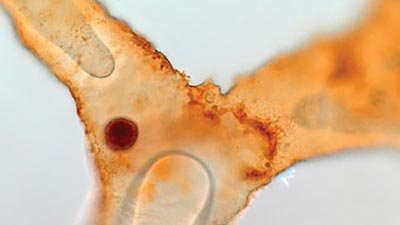
Soft Tissue found In Dinosaur Sparks New Debate
Reuters: “Scientists Question Dinosaur Soft Tissue Find” Not so fast! The much-publicized soft tissue found inside a T. rex thigh bone (supposedly millions of years old) may not be dinosaur protein after all, if the research of a University of Washington scientist is correct.
In the 1990s, a team led by Mary Schweitzer (of Montanta State University then and North Carolina State University now) located soft, fibrous, unfossilized tissue , including what appeared to be and acted like blood vessels and blood cells , inside a T. rex thigh bone that had been cracked open. Her discovery shocked paleontologists and sparked a new debate over the age of dinosaur fossils—and, by implication, the age of the entire fossil record and thus the age of the earth. While young-earth creationists pointed to the find as evidence against the old-earth paradigm, evolutionists tripped over themselves trying to explain how fresh blood cells could have lasted 65 million years (or more).
Evolutionists tripped over themselves trying to explain how fresh blood cells could have lasted 65 million years (or more).
Looking to replicate Schweitzer’s research, University of Washington paleontologist Thomas Kaye went to the same formation where Schweitzer’s team found the now-famous T. rex sample. He recovered a dinosaur bone of his own, cracked it open, and then dissolved the tissue in acid just as Schweitzer had done.
Reporting in PLoS One, Kaye says his team identified in “their” bone the same features that were previously (by Schweitzer’s team) identified as remnants of blood cells. Kaye’s team instead believes they are microscopic, iron-containing mineral spheres. The team also claims to have found similar structures inside bones from other creatures.
As for the stretchy material Schweitzer, et al., had identified as containing collagen—and which a Harvard team concluded last year was a bird- and alligator-like protein—Reuters reports that Kaye’s team believes it is instead “bacterial biofilm, a slimy substance that the microbes often form.” Kaye thinks the bacteria that once lived inside the T. rex’s real blood vessels produced the biofilm.
“We are not experts in the field,” Kaye told Reuters in a telephone interview, adding:
“We are not disagreeing with the fact that their instruments detected protein. We are offering an alternative explanation. We determined that these structures were too common to be exceptionally preserved tissue. We realized it couldn’t be a one-time exceptional preservation.”
Of course, since dinosaur bones are not routinely broken open, the preservation exhibited by the bones Schweitzer’s team discovered doesn’t have to be a one-time exceptional preservation (and, in fact, we suspect that it may not be).
In fact, the most abstract note we might make on this news is that even if the “facts” change (as they often do when fallible humans, with imperfect knowledge, conduct investigations), the paradigms and presuppositions nonetheless stay the same. Bible-believers will continue to start with Genesis, whereas evolutionists will continue to stretch the data into a timeline long enough to incorporate evolution.
For more information:
Remember, if you see a news story that might merit some attention, let us know about it! (Note: if the story originates from the Associated Press, Fox News, MSNBC, the New York Times, or another major national media outlet, we will most likely have already heard about it.) And thanks to all of our readers who have submitted great news tips to us.
(Please note that links will take you directly to the source. Answers in Genesis is not responsible for content on the websites to which we refer. For more information, please see our Privacy Policy.)
Recommended Resources

Answers in Genesis is an apologetics ministry, dedicated to helping Christians defend their faith and proclaim the good news of Jesus Christ.
- Customer Service 800.778.3390
- Available Monday–Friday | 9 AM–5 PM ET
- © 2025 Answers in Genesis




